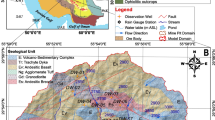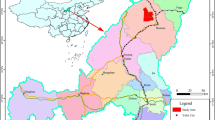Abstract
In this paper, we describe the hydrogeological problems related to the closure of the mine at Gavorrano (Tuscany, Italy). The geological and geo-structural settings of the Gavorrano area affect the groundwater flow systems and their chemical composition; hence, the settings also affect the chance and modalities to rehabilitate and re-utilize these water resources. This paper reports the results of studies, analyses of existing data and the consequent implementation of preliminary numerical models with particular reference to the effects of controlled water recovery and the complex measures required for stopping dewatering. The study incorporates recent data and the available historical records in an analysis of the hydrodynamic impact of water recovery and an assessment of the consequences of water recovery for water resources restoration. The applied numerical simulations have been demonstrated to be a promising and effective tool for planning and managing the future applications of groundwater recovery in the Gavorrano mining area. Using these applications, it will be possible to implement mitigation measures and types of re-use that consider thermal, chemical and discharge features.




















Similar content being viewed by others
References
Acocella V, Rossetti F (2002) The role of extensional tectonics at different crustal levels on granite ascent and emplacement: an example from Tuscany (Italy). Tectonophysics 354:71–83
Adams R, Parkin G (2002) Development of a coupled surface groundwater-pipe network model for the sustainable management of karstic groundwater. Environ Geol 42:513–517. doi:10.1007/s00254-001-0513-8
Adams R, Younger PL (2001) A strategy for modeling groundwater rebound in abandoned deep mine systems. Ground Water 39(2):249–261
Andersson J, Dverstorp B (1987) Conditional simulations of fluid flow in three dimensional networks of discrete fractures. Water Resour Res 23:1876–1886
Baldi P, Bellini S, Ceccarelli A, Fiordalisi A, Rocchi G, Squarci P, Taffi L (1995) Geothermal anomalies and structural features of Southern Tuscany (Italy). In: Proceedings of the world geothermal congress, 18–31 May 1995, Florence, Italy, pp 1287–1291
Banks D, Younger PL, Dumpleton S (1996) The historical use of mine-drainage and pyrite-oxidation waters in central and eastern England, United Kingdom. Hydrogeol J 4(4):55–68
Barazzuoli P, Nocchi M, Rigati R, Salleolini M (2008) A conceptual and numerical model for groundwater management: a case study on a coastal aquifer in Southern Tuscany. Hydrogeol J 16(8):1557–1576
Bear J (1972) Dynamics of fluids in porous media. American Elseviers Pub. Co., New York
Bell FG, Bullock SET (1996) The problems of acid mine drainage, with an illustrative case history. Environ Eng Geosci II(3):369–392
Brouyère S, Orban P, Wildemeersch S, Couturier J, Gardin N, Dassargues A (2008) The hybrid finite element mixing cell method: a new flexible method for modelling mine water problems. In: Proceedings of the 10th international mine water association congress, 2–5 Jun 2008, Karlovy Vary, Czech Republic, pp 429–431. ISBN: 9788024817675
Cacus MC, Ledoux E, De Marsily G, Tille B, Barbreau A, Durand E, Feuga B, Peaudecerf P (1990) Modeling of fracture flow with a stochastic discrete fracture network: calibration and validation: 1. The flow model. Water Resour Res 26(3):479–489
Carrera J, Heredia J, Vomvoris S, Hufschmied P (1990) Modeling of flow on a small fractured monzonitic gneiss block. Selected paper in hydrogeology of low permeability environments. Int Assoc Hydrogeol Hydrogeol 2:115–167
Civita M, Cocozza T, Forti P, Perna G, Turi B (1983) Idrogeologia del bacino minerario dell’Iglesiente (Sardegna sud occidentale). Memorie Istituto Italiano di Speleologia, II(2), SAMIM, Roma
Civita M, Guarascio M, Pelizza S, Antonietti M, Fioravanti E, Lipari D (1994) L’interruzione, in condizioni controllate, dell’eduzione nel bacino minerario di Iglesias (Sardegna sud-occidentale). De Re Metallica, Torino, pp 289–297
Craig H (1961) Isotopic variations in meteoric waters. Science 133:1702–1703
Crosta G, Garzonio CA (1996) Subsidence and slope deformation phenomena in the Gavorrano mining area. Geografia Fisica e Dinamica Quaternaria 19:315–323
Crosta G, Garzonio CA (1998a) Engineering geology problems in the closing down of mining areas. I: relationships among mining, geology and subsidence problems. In: Sivakumar M, Chowdhury RN (eds) Proceedings of the second international conference on environmental management (ICEM2), 10–13 February 1998, Wollongong, Australia. Elsevier, Amsterdam, pp 1141–1151
Crosta G, Garzonio CA (1998b) Engineering geology problems in the closing down of mining areas II: hydrogeological problems of mining rehabilitation. In: Sivakumar M, Chowdhury RN (eds) Proc of the second international conference on environmental management (ICEM2), 10–13 February 1998, Wollongong,Australia. Elsevier, Amsterdam, pp 1153–1162
Crosta G, Garzonio CA (2000) The underground water storage project in the decommissioned Gavorrano mine (Tuscany, Italy). In: Proceedings of Eurock 2000, Aachen, Germany, pp 387–393
Del Greco O, Garzonio CA, Oggeri C (2008) Stability and environmental problems due to groundwater level raising in the abandoned Gavorrano mine. In: 10th international mine water association on mine water and the environment, 2–5 June 2008, Karlovy Vary, Czech Republic, pp 131–134. ISBN: 9788024817675
Diersch HJG (2005) FEFLOW finite element subsurface flow and transport simulation system, reference manual. WASY Institute for Water Resources Planning and Systems Research, Berlin
Garzonio CA (2000) Dewatering and the tourist potential of hydrogeological resources of the Gavorrano mine, Tuscany, Italy. In: Sililo O (ed) Proceedings of the XXXII IAH congress on groundwater, 26 November–1 December 2000, Cape Town, South Africa. Balkema, Amsterdam, pp 1107–1112
Garzonio CA, Affuso AMG (2004) Hydrogeological problems for the rehabilitation and re-utilisation of the water resources of the mining area of Gavorrano (Italy). Environ Geol 46:286–294
Gburek WJ, Folmar GJ, Urban JB (1999) Field data and ground water modeling in a layered fractured aquifer. Ground Water 37(2):175–184
Gongyu L, Wanfang Z (2006) Impact of karst water on coal mining in North China. Environ Geol 49:449–457
Hsieh PA, Neuman SP (1985) Field determination of the three dimensional hydraulic conductivity tensor of anisotropic media, 1. Theory. Water Resour Res 21(11):1655–1665
Hsieh PA, Neuman SP, Stiles GK, Simpson ES (1985) Field determination of the three dimensional hydraulic conductivity tensor of anisotropic media: 2. Methodology and application to fractured rocks. Water Resour Res 21(11):1667–1676
Kanit T, Forest S, Galliet I, Mounoury V, Jeulin D (2003) Determination of the size of the representative volume element for random composites: statistical and numerical approach. Int J Solids Struct 40:3647–3679
Kryza J, Stasko S (2000) Groundwater flow rate and contaminant migration in fissure-karstic aquifer of Opole Triassic system southwest Poland. Environ Geol 39(3–4):384–389
Kulatilake PHSW, Panda BB (2000) Effect of block size and joint geometry on jointed rock hydraulics and REV. J Eng Mech 126(8):850–858
Lienhoop N, Messner F (2009) The economic value of allocating water to post-mining lakes in East Germany. Water Resour Manag 23(5):965–980
Long JCS, Remer JS, Wilson CR, Witherspoon PA (1982) Porous media equivalents for networks of discontinuous fractures. Water Resour Res 18:645–658
Louis C (1974) Rock hydraulics. In: Müller L (ed) Rock mechanics. International Centre for Mechanical Sciences, Springer Verlag, Wien, New York
Malolepszy Z (2003) Low-temperature, man-made geothermal reservoirs in abandoned workings of underground mines. In: Proceedings of the 28th workshop on geothermal reservoir engineering, Stanford University, USA, pp 259–265
Mun Y, Uchrin CG (2004) Development and application of a MODFLOW preprocessor using percolation theory for fractured media. J Am Water Resour Assoc 40(1):229–239
Nash EJ (1993) Dewatering concepts at Zambian copperbelt mines. Mine Water Environ 2(3):34–45
Neuman SP, Depner JS (1988) Use of variable-scale pressure test data to estimate the log hydraulic conductivity covariance and dispersivity of fractured granites near Oracle, Arizona. J Hydrol 102(1–4):475–501
Oda M (1985) Permeability tensor for discontinuous rock masses. Geotechnique 35(4):483–495
Pankow JF, Johnson RL, Hewetson JP, Cherry JA (1986) An evaluation of contaminant migration patterns at two waste disposal sites on fractured porous media in terms of the equivalent porous medium (EPM) model. J Contam Hydrol 1:65–76
Paradis D, Martel R, Karanta G, Rene R, Michaud Y, Therrien R, Nastev M (2007) Comparative study of methods for WHPA delineation. Ground Water 45(2):158–167
Piccinini L, Vincenzi V (2010) Impacts of a railway tunnel on the streams baseflow verified by means of numerical modelling. Aqua Mundi 1(2):123–134
Pruess K, Narasimhan TN (1985) Practical method for modelling fluid and heat flow in fractured porous media. Soc Petrol Eng J 25(1):14–26
Rayne TW, Bradbury KR, Muldoon MA (2001) Delineation of capture zones for municipal wells in fractured dolomite, Sturgen Bay, Wisconsin, USA. Hydrogeol J 9:432–450
Renz A, Rühaak W, Schätzl P, Diersch HJG (2009) Numerical modelling of geothermal use of mine water: challenges and examples. Mine Water Environ 28:2–14
Sammarco O (1993) Karst and thermal water in an underground mine during and after exploitation. In: Proceedings of the 1st African symposium on mine drainage and environmental protection from mine waste water disposal, 13–17 Sept 1993, Chililabombwe, Zambia, pp 671–682
Sammarco O (1995) Storage of water in the voids of abandoned mines and fractured rocks. Mine Water Environ 14(1):57–70
Scanlon BR, Mace RE, Barrett ME, Smith B (2003) Can we simulate regional groundwater flow in a karst system using equivalent porous media models? Case study, Barton Springs Edwards Aquifer, USA. J Hydrol 276:137–158
Schwartz FW, Smith WL, Crowe AS (1983) A stochastic analysis of microscopic dispersion in fractured media. Water Resour Res 19:253–1265
Shapiro AM, Andersson J (1985) Simulation of steady state flow in three dimensional fracture networks using boundary element method. Adv Water Resour 8(3):106–110
Sharma D, Cole SE, Straskraba V (1991) Mathematical modelling of the Konkola mine dewatering. In: Proceedings of the 4th international mine water congress, September 1991, Ljubljana/Pörtschach, Slovenia/Austria, pp 149–162
Sudicky EA, McLaren RG (1992) The Laplace transform Galerkin technique for large-scale simulation of mass transport in discretely fractured porous formations. Water Resour Res 28(2):499–514
Trefry MG, Muffels C (2007) FEFLOW: a finite-element ground water flow and transport modeling tool. Ground Water 45(5):525–528
Vincenzi V, Piccinini L, Gargini A, Sapigni M (2010) Parametric and numerical modelling tools to forecast hydrogeological impacts of a tunnel. Aqua Mundi 1(2):135–154
Wang M, Kulatilake PHSW, Panda B, Rucker ML (2001) Groundwater resources evaluation case study via discrete fracture flow modeling. Eng Geol 62(4):267–291
Wolkersdorfer C (2008) Water management at abandoned flooded underground mines: fundamentals, tracer tests, modelling, water treatment. Springer, Heidelberg
Wolkersdorfer C, Bowell R (2004) Contemporary reviews of mine water studies in Europe. Mine Water Environ 23:162–182
Worthington SRH (2009) Diagnostic hydrogeologic characteristics of a karst aquifer (Kentucky, USA). Hydrogeol J 17:1665–1678
Younger PL, Banwart SA, Hedin RS (2002) Mine water: hydrology, pollution, remediation. Kluwer Academic Publishers, Dordrecht
Zuppi GM (1986) Introduzione all’idrologia isotopica. In: Zavatti A (ed) Proc Conf su Ambiente Protezione e Risanamento, Pitagora Ed 1:281–335
Author information
Authors and Affiliations
Corresponding author
Rights and permissions
About this article
Cite this article
Garzonio, C.A., Piccinini, L. & Gargini, A. Groundwater Modeling of Fractured Aquifers in Mines: The Case Study of Gavorrano (Tuscany, Italy). Rock Mech Rock Eng 47, 905–921 (2014). https://doi.org/10.1007/s00603-013-0444-1
Received:
Accepted:
Published:
Issue Date:
DOI: https://doi.org/10.1007/s00603-013-0444-1




